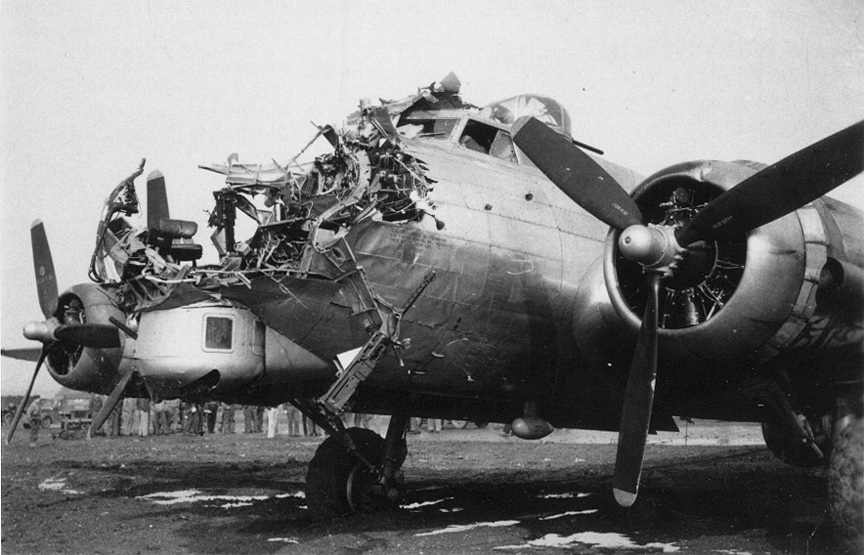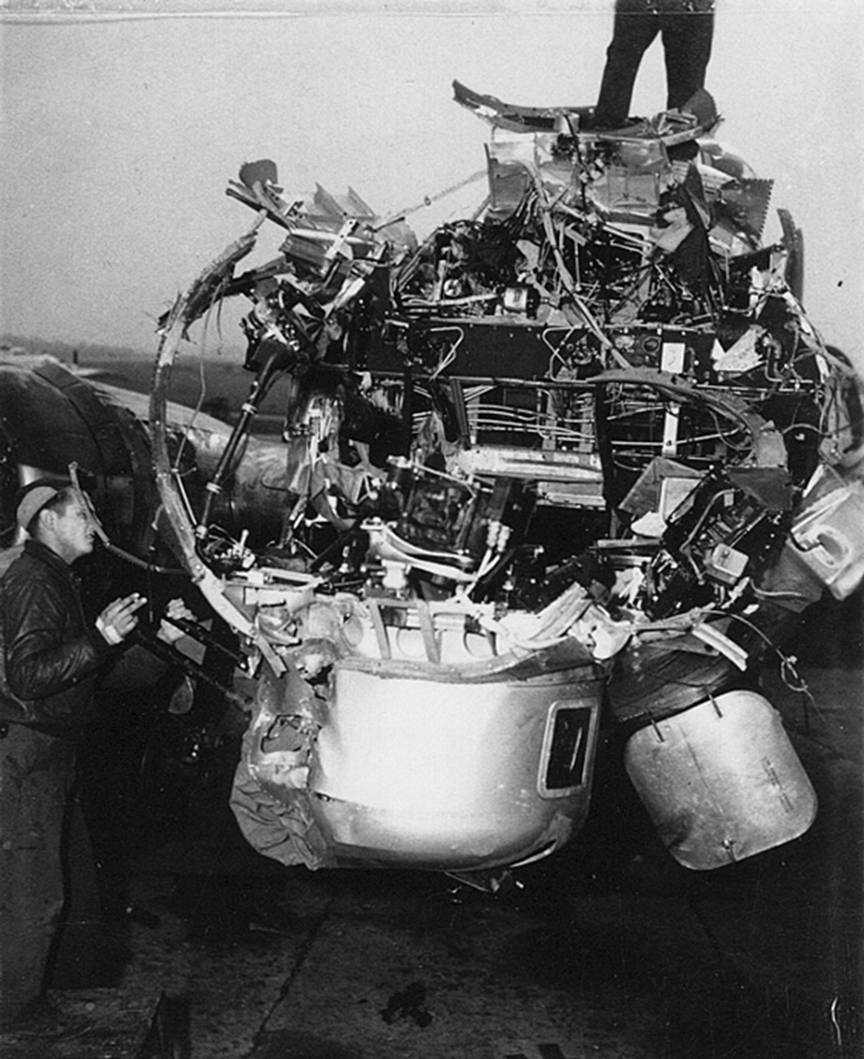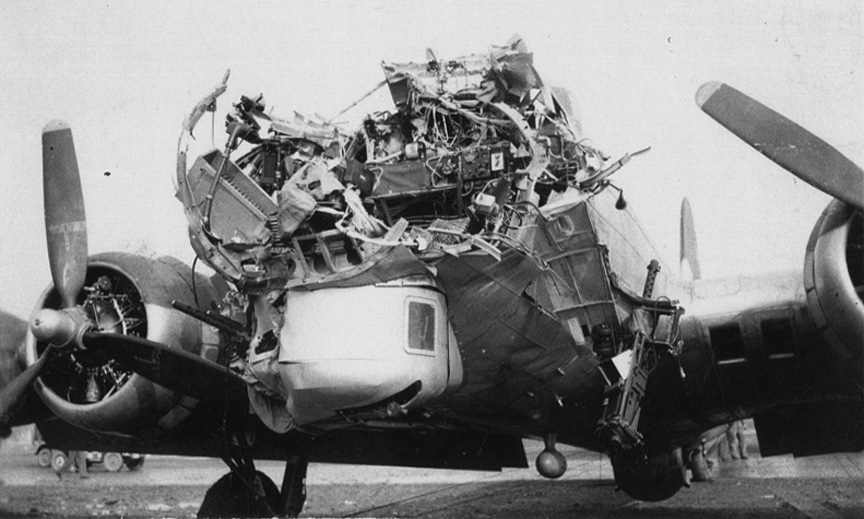
The WW2 Flying Fortresses coming home with their dead and wounded. Those B-29
engines were remarkable. I witnessed a B-17 flying out of Guam returning from a
bombing mission over Japan. It was making an emergency landing on a captured
airfield on Okinawa. It hit the runway ok but then it broke into a big ball of
fire. I never did hear what happened but scuttlebutt had it that there were no
survivors. From what I saw I never doubted this scuttlebutt. I think it would
have been better if they had crash landed in the ocean but I have the benefit of
hindsight.
Bob

GOOD EXAMPLE OF “A WING & A PRAYER!”
Tough old war bird.
Fortress Coming Home!
A great story about the crew of a fortress with the 'Mighty Eighth' during Oct.
'44.
IT WAS A FORTRESS COMING HOME. They Could Hear It Before They Could See it
By Allen Ostrom
They could hear it before they could see it!
Not all that unusual in those days as the personnel at Station 131 gathered
around the tower and scattered hardstands to await the return of the B-17's sent
out earlier that morning.
First comes the far off rumble and drone of the Cyclones. Then a spec on the
East Anglia horizon. Soon a small cluster indicating the lead squadron.
Finally, the group.
Then the counting. 1-2-3-4-5... ...
But that would have been normal. Today was different! It was too early for
the group to return. "They're 20 minutes early. Can't be the 398th."
They could hear it before they could see it! Something was coming home. But
what? All eyes turned toward the northeast, aligning with the main runway,
each ground guy and stood-down airman straining to make out this "wail of a
Banshee," as one called it.
Not like a single B-17 with its characteristic deep roar of the engines
blended with four thrashing propellers. This was a howl! Like a powerful wind
blowing into a huge whistle.
Then it came into view. It WAS a B-17!
 Low
and pointing her nose at the 6,000 foot runway, it appeared for all the world to
be crawling toward the earth, screaming in protest. Low
and pointing her nose at the 6,000 foot runway, it appeared for all the world to
be crawling toward the earth, screaming in protest.
No need for the red flares. All who saw this Fort knew there was death
aboard.
"Look at that nose!" they said as all eyes stared in amazement as this
single, shattered remnant of a once beautiful airplane glided in for an
unrealistic "hot" landing. She took all the runway as the "Banshee" noise
finally abated, and came to an inglorious stop in the mud just beyond the
concrete runway. Men and machines raced to the now silent and lonely
aircraft. The ambulance and medical staff were there first. The fire
truck....ground and air personnel... .jeeps, truck, bikes.....
Out came one of the crew members from the waist door, then another.
Strangely quiet. The scene was almost weird. Men stood by as if in shock, not
knowing whether to sing or cry. Either would have been acceptable. The
medics quietly made their way to the nose by way of the waist door as the
remainder of the crew began exiting. And to answer the obvious question,
"what happened?"
"What happened?" was easy to see. The nose was a scene of utter
destruction. It was as though some giant aerial can opener had peeled the
nose like an orange, relocating shreds of metal, Plexiglas, wires and tubes on
the cockpit windshield and even up to the top turret. The left cheek gun hung
limp, like a broken arm. One man pointed to the crease in the chin turret. No
mistaking that mark! A German 88 anti-aircraft shell had exploded in the lap of
the togglier.
This would be George Abbott of Mt. Labanon, PA. He had been a waist
gunner before training to take over the bombardier's role. Still in the
cockpit, physically and emotionally exhausted, were pilot Larry
deLancey and co-pilot Phil Stahlman.
Navigator Ray LeDoux finally tapped deLancey on the shoulder and suggested
they get out. Engineer turret gunner Ben Ruckel already had made his way to the
waist was exiting along with radio operator Wendell Reed, ball turret gunner Al
Albro, waist gunner Russell Lachman and tail gunner Herbert Guild.
Stahlman was flying his last scheduled mission as a replacement for
regular co-pilot, Grady Cumbie. The latter had been hospitalized the day before
with an ear problem.. Lachman was also a "sub," filling in for Abbott in the
waist.
DeLancey made it as far as the end of the runway, where he sat down with
knees drawn up, arms crossed and head down. The ordeal was over, and now the
drama was beginning a mental re-play.
Then a strange scene took place.
Group CO Col. Frank P. Hunter had arrived after viewing the landing from
the tower and was about to approach deLancey. He was physically restrained by
flight surgeon Dr. Robert Sweet. "Colonel, that young man doesn't want to
talk now. When he is ready you can talk to him, but for now leave him alone."
Sweet handed pills out to each crew member and told them to go to their
huts and sleep. No dramatics, no cameras, no interviews. The crew would
depart the next day for "flak leave" to shake off the stress. And then be
expected back early in November. (Just in time to resume "normal" activities on
a mission to Merseburg!) Mission No. 98 from Nuthampstead had begun at
0400 that morning of October 15, 1944. It would be Cologne (again), led by CA
pilots Robert Templeman of the 602nd, Frank Schofield of the 601st and Charles
Khourie of the 603rd.
Tragedy and death appeared quickly and early that day. Templeman and pilot
Bill Scott got the 602nd off at the scheduled 0630 hour, but at approximately
0645 Khouri and pilot Bill Meyran and their entire crew crashed on takeoff in
the town of Anstey. All were killed. Schofield and Harold Stallcup followed
successfully with the 601st, with deLancey flying on their left wing in the lead
element.
The ride to the target was routine, until the flak started becoming
"unroutinely" accurate.
"We were going through heavy flak on the bomb run," remembered deLancey.
"I felt the plane begin to lift as the bombs were dropped, then all of a
sudden we were rocked by a violent explosion. My first thought - 'a bomb
exploded in the bomb bay' - was immediately discarded as the top of the nose
section peeled back over the cockpit blocking the forward view."
"It seemed like the whole world exploded in front of us," added Stahlman.
"The instrument panel all but disintegrated and layers of quilted batting
exploded in a million pieces. It was like a momentary snowstorm in the cockpit."
It had been a direct hit in the nose. Killed instantly was the togglier,
Abbott. Navigator LeDoux, only three feet behind Abbott, was knocked unconscious
for a moment, but was miraculously was alive. Although stunned and
bleeding, LeDoux made his way to the cockpit to find the two pilots struggling
to maintain control of an airplane that by all rights should have been in its
death plunge. LeDoux said there was nothing anyone could do for Abbott, while
Ruckel opened the door to the bomb bay and signaled to the four crewman in the
radio room that all was OK - for the time being.
The blast had torn away the top and much of the sides of the nose.
Depositing enough of the metal on the windshield to make it difficult for either
of the pilots to see. "The instrument panel was torn loose and all the
flight instruments were inoperative with the exception of the magnetic compass
mounted in the panel above the windshield. And its accuracy was questionable.
The radio and intercom were gone, the oxygen lines broken, and there was a
ruptured hydraulic line under my rudder pedals," said deLancey.
All this complicated by the sub-zero temperature at 27,000 feet blasting
into the cockpit. "It was apparent that the damage was severe enough that
we could not continue to fly in formation or at high altitude. My first concern
was to avoid the other aircraft in the formation, and to get clear of the other
planes in case we had to bail out. We eased out of formation, and at the same
time removed our oxygen masks as they were collapsing on our faces as the tanks
were empty."
At this point the formation continued on its prescribed course for home -
a long, slow turn southeast of Cologne and finally westward. DeLancey and
Stahlman turned left, descending rapidly and hoping, they were heading west.
(And also, not into the gun sights of German fighters.) Without maps and
navigation aids, they had difficulty getting a fix. By this time they were down
to 2,000 feet.
"We finally agreed that we were over Belgium and were flying in a
southwesterly direction," said the pilot.
"About this time a pair of P-51's showed up and flew a loose formation on
us across Belgium. I often wondered what they thought as they looked at the
mess up front."
"We hit the coast right along the Belgium-Holland border, a bit farther
north than we had estimated. Ray said we were just south of Walcheren Island."
Still in an area of ground fighting, the plane received some small arms
fire. This gesture was returned in kind by Albro, shooting from one of the waist
guns.
"We might have tried for one of the airfields in France , but having no
maps this also was questionable. Besides, the controls and engines seemed to be
OK, so I made the decision to try for home."
"Once over England , LeDoux soon picked up landmarks and gave me course
corrections taking us directly to Nuthampstead. It was just a great bit of
navigation. Ray just stood there on the flight deck and gave us the headings
from memory."
Nearing the field, Stahlman let the landing gear down. That was an
assurance. But a check of the hydraulic pump sent another spray of oil to the
cockpit floor. Probably no brakes! Nevertheless, a flare from Ruckel's
pistol had to announce the "ready or not" landing. No "downwind leg" and "final
approach" this time. Straight in!
"The landing was strictly by guess and feel," said DeLancey. "Without
instruments, I suspect I came in a little hot. Also, I had to lean to the left
to see straight ahead. The landing was satisfactory, and I had sufficient
braking to slow the plane down some. However, as I neared the taxiway, I could
feel the brakes getting 'soft'. I felt that losing control and blocking the
taxiway would cause more problems than leaving the plane at the end of the
runway."
That consideration was for the rest of the group. Soon three squadrons of
B-17's would be returning, and they didn't need a derelict airplane blocking the
way to their respective hardstands.
Stahlman, supremely thankful that his career with the 398th had come to an
end, soon returned home and in due course became a captain with Eastern
Airlines. Retired in 1984, Stahlman said his final Eastern flight "was a bit
more routine" than the one 40 years before.
DeLancey and LeDoux received decorations on December 11, 1944 for their
parts in the October 15 drama. DeLancey was awarded the Silver Star for his
"miraculous feat of flying skill and ability" on behalf of
General Doolittle,
CO of
the Eighth Air Force. LeDoux for his "extraordinary navigation skill",
received the Distinguished Flying Cross.
The following DeLancey 1944 article was transcribed from the 398th BG
Historical Microfilm. Note: due to wartime security, Northampstead is not
mentioned, and the route DeLancey flew home is referred to in general terms.
TO: STARS AND STRIPES
FOR GENERAL RELEASE
AN EIGHTH AIR FORCE BOMBER STATION, ENGLAND - After literally losing the nose of
his B-17 Flying Fortress as the result of a direct hit by flak over Cologne,
Germany on October 15, 1944, 1st Lt. Lawrence M. DeLancey, 25, of Corvallis,
Oregon returned to England and landed the crew safely at his home base.. Each
man walked away from the plane except the togglier, Staff Sergeant George E.
Abbott, Mt. Lebanon, Pennsylvania , who was killed instantly when the flak
struck.
"Just after we dropped our bombs and started to turn away from the
target", Lt. DeLancey explained, "a flak burst hit directly in the nose
and blew practically the entire nose section to threads. Part of the nose peeled
back and obstructed my vision and that of my co-pilot, 1st Lt. Phillip H. Stahlman of Shippenville, Pennsylvania. What little there was left in front of
me looked like a scrap heap. The wind was rushing through. Our feet were exposed
to the open air at nearly 30,000 feet above the ground the temperature was
unbearable.
"There we were in a heavily defended flak area with no nose, and
practically no instruments. The instrument panel was bent toward me as the
result of the impact. My altimeter and magnetic compass were about the only
instruments still operating and I couldn't depend on their accuracy too well. Naturally I headed for home immediately. The hit which had killed S/Sgt. Abbott
also knocked Lt. LeDoux back in the catwalk (just below where I was sitting).
Our oxygen system also was out so I descended to a safe altitude.
"Lt. LeDoux who had lost all his instruments and maps in the nose did a
superb piece of navigating to even find England .."
During the route home flak again was encountered but due to evasive action
Lt. DeLancey was able to return to friendly territory. Lt.. LeDoux navigated the
ship directly to his home field.
Although the plane was off balance without any nose section, without any
brakes (there was no hydraulic pressure left), and with obstructed vision, Lt.
deLancey made a beautiful landing to the complete amazement of all personnel at
this field who still are wondering how the feat was accomplished.
The other members of the crew include:
1. Technical Sergeant Benjamin H. Ruckel, Roscoe, California, engineer top
turret gunner;
2. Technical Sergeant Wendell A. Reed, Shelby, Michigan, radio operator
gunner;
3. Technical Sergeant Russell A. Lachman, Rockport, Mass., waist gunner;
4. Staff Sergeant Albert Albro, Antioch, California, ball turret gunner
5. Staff Sergeant Herbert D. Guild, Bronx , New York , tail gunner.
Photos and Stories from Robert Shackles |



